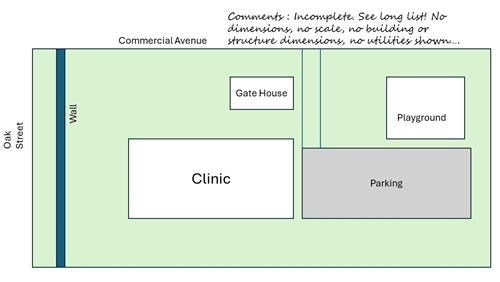An Introduction to Site Plan Review for Planning Commissioners
Reviewed: August 13, 2024
I like to see any municipal or county government add a requirement for site plan review if they do not employ this technique already. I just don't like a painfully long list of required graphics and narratives giving information that the local government is not equipped to evaluate.
The message of this page is simple: if you collect only the information that is relevant to whether the development will protect the health, safety, and welfare of future residents, employees, and visitors, you really should adopt a site plan review process.
If you don't know, municipal or county governments can incorporate this tool into the zoning ordinance or enact a separate standalone ordinance. Occasionally a small community that does not even use land use zoning requires site plan approval. Often tiny developments, such as a 2,500 square foot commercial building on a 0.2 acre lot, will be excluded from the requirement entirely.
Lastly, don't overlay a site plan review requirement on developments that are already covered under your subdivision regulation. In reality, this means that your site plan reviews will cover commercial and industrial buildings and complexes, as well as multi-family buildings or complexes. You get to decide if a single residence is subject to site plan review, a mini version of it, or no review at all.
 Worst Site Plan Ever--This Isn't What We Mean!
Worst Site Plan Ever--This Isn't What We Mean!However it is enacted, a site development plan approval process must describe three things: (a) the graphic and narrative information required for submission with an application, (b) a clear statement about the review process and who conducts it, and (c) criteria for approval.
At its most basic level, a site development plan shows the location of all proposed and existing buildings, provisions for vehicular and utility access, location of permanent features of the property such as commercial air conditioning units or fences, parking, landscaping, and more. A town or city must decide what information is necessary to determine whether the development will be safe, a satisfactory neighbor, and in compliance with the comprehensive plan and other plans and ordinances that govern development.
In many states the jurisdiction can choose which body approves site plans. Sometimes this power rests with plan commissions, but in other locales the city council also must approve them or even serve as the decision maker instead of the planning and zoning commission. Occasionally the planning staff or consultant is allowed to make the decisions, especially when criteria are very specific. Once in a while, the zoning board of appeals (also known as the board of adjustment or a variety of other names) has been given this authority. I cannot conceive of this latter option being a good choice though.
A third type of decision facing a municipality that wants to enact a site plan review requirement is what the criteria will be. Sometimes a bit of subjective interpretation of compatibility with a master plan or community standards is allowed, while others try to steer clear of anything that could be considered a judgment call. The latter is more common, with some states and experts even regarding site plan approval as a given if a checklist of criteria is met. Regardless of your town's choice, the enacting legislation should list the criteria.
Information You May Want to Require For Site Plan Review
The list of what your application may require is quite lengthy. Much of the information will be submitted graphically on any number of exhibits that are necessary to fully present existing and future conditions.
The application form itself should request the names and contact information for the applicant, current property owner if different, and persons who prepared the application and its plans, elevations, and diagrams. Also you will need to ask for a tax identification number or other unique parcel identifier in use in your jurisdiction. I always suggest a proposed construction schedule, including information on phasing of the development.
All site plan review applications should require a to-scale drawing of the entire property, existing roads and streets within or adjacent to the property, current zoning districts, existing structures and whether they will remain, and proposed buildings and structures. Depending on the goals and vision of your community as detailed in your comprehensive plan and other approved official plans, you no doubt will want to request, and in fact insist upon, a long laundry list of other information.
Below I have grouped some of the possibilities. Just keep in mind my caution that you will have better community acceptance if you can justify why you include each required item. If you don't know what to do with the information you wish to collect, either beef up your staffing or consultant services, or don't ask. Site plan review should not be an exercise in hassling developers, businesspersons, or property owners.
Here is some information you potentially need:
1. How ownership ultimately will be held. Are partial ownerships to be sold, will one entity own and lease out the space, will ownership be cooperative, or what does the applicant foresee?
2. Detailed information about streets (including widths and elevations), utilities, and property ownership within a certain radius may be required.
3. Detailed access plan, including ingress, egress, traffic control measures such as stop signs , one-way indicators, speed bumps or other traffic calming measures, and medians.
4. Proposed parking lots, driveways, truck access points, loading docks, EV charging stations, curbside parking or temporary loading zones, crosswalks, and bicycle lanes and bike storage. Profiles and cross-sections of internal roads, as well as intersection details and turning radii, will be important in most situations, but especially if there will be heavy truck traffic.
5. Outdoor lighting, loudspeakers, signs, retaining walls, large exterior air conditioning units or air handlers, dumpsters, retaining walls, utility service boxes, and outdoor storage yards or units.
6. Topographic map, grading plan, and drainage plan, including locations of new drainageways, retention ponds, and culverts.
7. Easements, setbacks, reservations, or parks or open spaces to be open to the public.
8. Details of the location, capacity, and adequacy of utilities and the development's connections to them, as well as any proposed new utility arrangements, with particular attention to water and sewer lines, solar arrays, and energy distribution facilities.
9. Description of existing and proposed vegetative cover, diagram showing the location of trees of a specified minimum caliper, soils and geology information as may be relevant in your location, general locations of any known endangered species, wetlands, floodplains, and brownfield sites. If there are any known archaeological or historic sites anywhere on the property, you should ask for complete documentation. Copies of any environmental or other permits already applied for or obtained should be supplied. It is sensible to require more environmental information from large developments than from a minor commercial building on a small lot. Again, adapt this list to local sensibilities and omit duplication with reviews required by state or federal law.
10. Deed restrictions and covenants applicable to any portion of the site.
11. Height, number of stories, total floor area, materials and their specifications, and use of all proposed buildings or existing buildings to be retained. I recently consulted with a city that was considering a requirement for safe rooms to be used in the event of tornadoes or active shooter situations. I know of one that requires a flash flooding safe area above the ground floor.
12. Proposed fire hydrants and fire lanes.
13. You may handle architectural plans through a separate architectural review board or process. Alternatively, during site plan review, the reviewing body may comment on architecture and evaluate compatibility of the proposal with local design guidelines or even a local historic district, if those matters are not already delegated to different bodies or the staff of your jurisdiction. Personally, I think those are different skill sets than those typical of planning commissioners and elected officials, but adapting this overview to your own setting is essential.
14. I recommend reserving the right to request other information and drawings that the reviewing body finds necessary to evaluate the impact of the proposed site development plan on neighboring property and the city's infrastructure and comprehensive plan.
15. I find that asking the applicant to describe how the proposed development fits the comprehensive plan is pointless. The applicant probably is not nearly as familiar with your master plan as you are! So don't be lazy; think this through on your own.
Deciding on the Process for Site Development Plan Approval
As mentioned in the introduction, a critical decision early in setting up site plan review is delineating what body or staff role has the decision making authority. A good, middle-of-the-road recommendation for a city of more than about 20,000 residents is to put the plan commission in charge but require that they obtain professional advice from their own staff planner, zoning commissioner, or building official, or else an outside consultant. The professional should be charged with conferring with public safety, transportation, utility, and environmental officials as appropriate.
Generally you would want to make your site plan approval process as parallel to the approval of subdivision plats as possible, although you need to recognize that site plans for large commercial or industrial complexes may be considerably more complex than an all-residential subdivision. If a particular detail is required on your plats, you probably should require the same thing on site plans. For instance, I did not mention a north arrow or an engineer's seal above, but of course I don't mean that you could let those things slide.
An important feature of most quality site plan approval ordinances or chapter in the zoning ordinance is setting forth a time limit for the approval. You might want a 60-day maximum for simpler projects, whereas major developments, as defined by either total land area or perhaps gross floor area, might need a six-month time limit. Consider the sheer number of different entities that control the necessary information in your location, and allow developers more time if your system is complex to navigate or if utilities and engineering firms are stretched thin already.
You also need to figure out what the appeal process will be if site plan approval is denied. Talk with your city attorney about this to get some suggestions, since state law or case law may be relevant.
Also think through the fee you need to charge for site plan review. In many cases, these reviews require even more time than rezoning applications, and your jurisdiction probably wants to break even when staff time is considered.
Site Plan Review Criteria
Over the course of a planning career, I have moved steadily over toward the camp that would say your criteria should be as explicit as possible and as objective as you can make them. This is partly due to increasing boldness about litigation against towns and cities that are just trying to carry out basic planning functions. In today's judicial environment in some states, I would not want to be defending a subjective determination that this site plan is incompatible with its neighbors, regardless of which public body or staff person makes that decision.
By the way, that is an argument for moving site plan approval to the highest ranking body, namely your city council, which would enjoy the greatest presumption of validity in the courts. It also is an argument against allowing a single staff member, such as the building commissioner or the planning director, to make the determination.
To begin to draft the criteria, simply take the list of submissions that you have decided to require, and turn each requirement into a statement of why that is important. If you think you need to ask for the locations of retaining walls, outdoor signs, and air handlers, for example, is that because you want to make sure that drivers can see around corners, you want pedestrians to be able to move around safely, you want to guard against too much visual clutter, you don't want some hulking structure towering over the nearby subdivision, or what? Thinking through the "why" behind each required item of information will lead to a written list of the criteria by which the site plan is being judged.
Here I should mention that it may be better to begin with the criteria than to begin with what materials must be submitted with the application, but my experience suggests that many of you would ignore that advice.
To incorporate some of the less quantifiable considerations into the site plan approval process, you will probably want to draft some findings of fact for the decision making body to vote on. These can be broad statements, such as:
- The City Council finds that Development ABC is compatible with the City's comprehensive plan of 2019.
- The City finds that electricity, natural gas, water, and sewer utilities are adequate in quality and capacity to serve the proposed development.
- After Public Works Department review, the City finds that the proposed methods of ingress and egress for the proposed site development plan are adequate to meet the internal needs of the development and will not lower the current level of service of any adjacent road.
- The City Council finds that the location, layout, and facilities of the proposed development will allow fire, police, and other emergency services to perform their work unimpeded.
You will probably want to be much more explicit than these examples suggest, but they also show that your findings need not cite solely data and numbers.
Summary of Site Plan Review Issues
In sum, if you are contemplating a new site plan review ordinance (or addition to your zoning or unified land use regulation), you need to decide:
1. What information you need to evaluate how a proposed private development will impact the public good
2. What public body, together with its professional staff, is best equipped to provide site plan review within an acceptable timeframe
3. The criteria that a site plan must meet.
Choose wisely, both to conserve staff time and resources and to minimize objections from developers, builders, property owners, and the public. On the other hand, don't be afraid to impose requirements and criteria that will advance the public purposes you already have embraced in your comprehensive plan or other approved city or county ordinances.
- Making and Keeping a Good Community ›
- Zoning and Codes › Site Plan Review
Join GOOD COMMUNITY PLUS, which provides you monthly with short features or tips about timely topics for neighborhoods, towns and cities, community organizations, and rural or small town environments. Unsubscribe any time. Give it a try.

